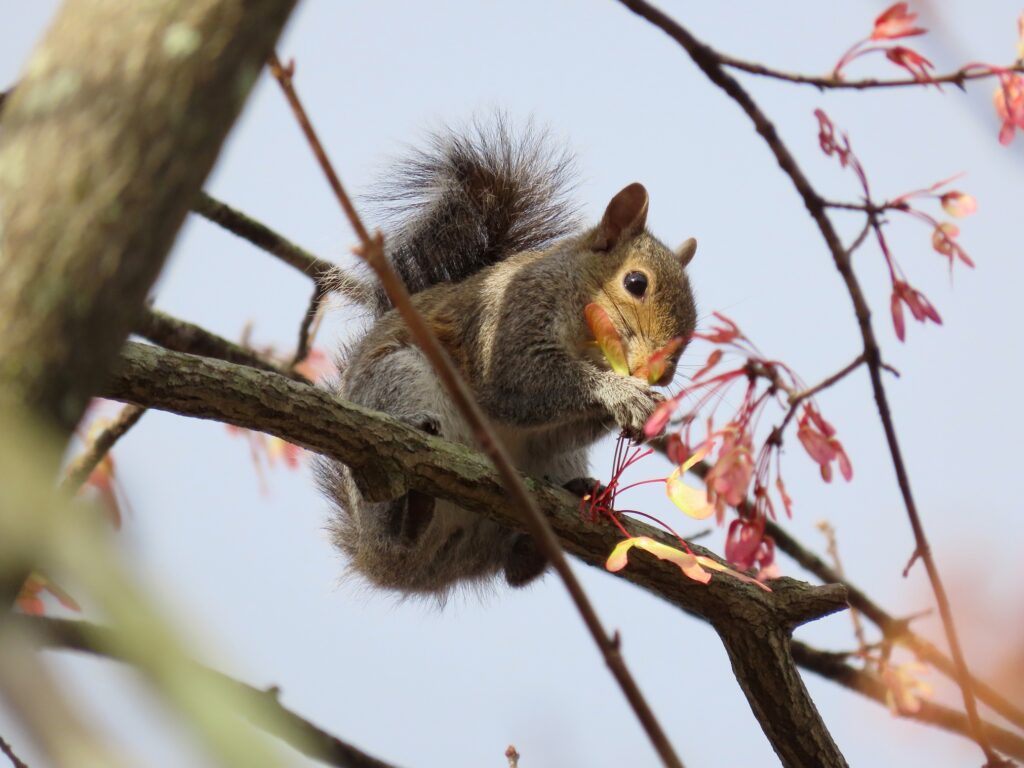
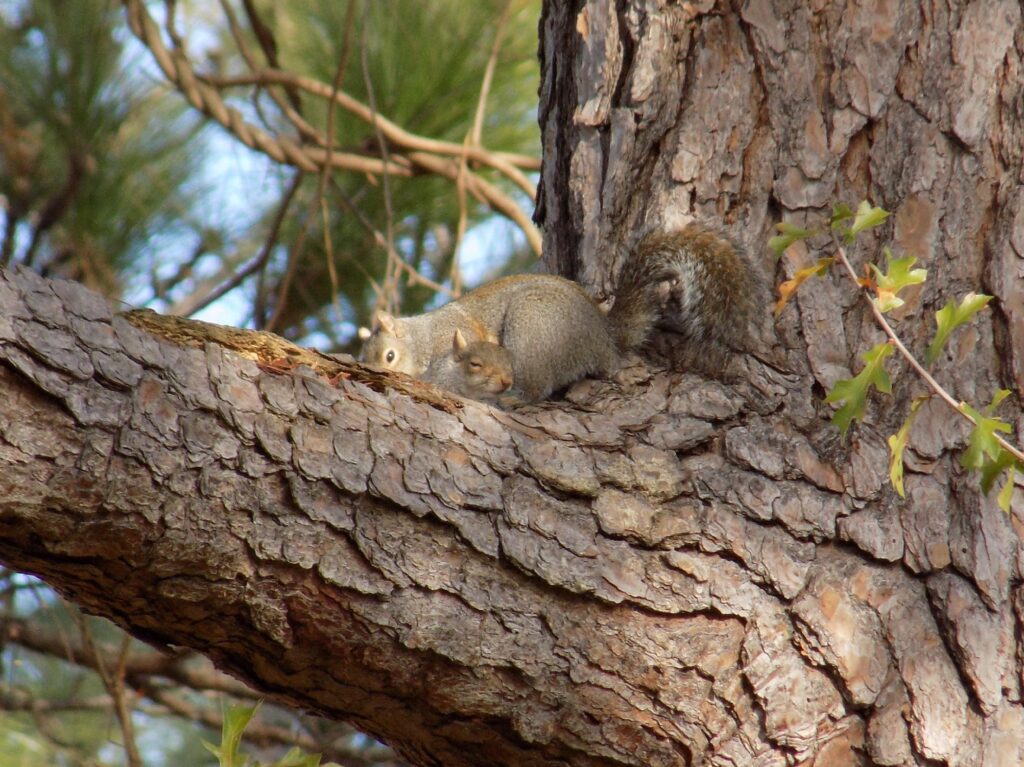

This week for Flora and Fauna Friday it’s everyone favorite tree rat, the Eastern Gray Squirrel (Sciurus carolinensis).
Gray Squirrels are our most common and widespread arboreal rodent in the Southeast. They’re usually about ten inches long (double that with the tail) and weigh a pound. Their coat is a glossy gray with warm-brown accents speckled in a mist of white flecks that radiate from their snowy belly. Like our other two Squirrels they have bushy tails, round ears, big eyes, and eat nuts. Unlike our other squirrels, they also eat pizza and french fries, among many other things. This is because the Eastern Gray Squirrel is a generalist. They live anywhere in this state where seeds and trees exist in the same space. Their diet consists principally of acorns, pine nuts, maple seeds, hickory nuts, sweet gum balls, and any other tree nuts then can get their hands and teeth on. Gray Squirrels access the meaty morsels of nuts using their curved, chisel-like chompers. Like all rodents their incisors are wedge shaped and overlap like sheers, allowing them to forcefully and precisely dismember wood, plastic, and even bone. The diet of the Gray Squirrel is broad and extends far beyond nuts. They also eat fruits, mushrooms, pizza, bark, insects, foliage, birdseed, and skeletons. Bones and shed deer antlers are a favorite snack of squirrels because they’re high in minerals that are often lacking in their regular diets. Their urbanized populations continue to subsist mainly on tree nuts but supplement their meals with discarded pizza crusts, wayward French fries, and as much birdseed as they can funnel down their bottomless gullet in one sitting.
When they’re not bankrupting birdwatchers, Gray Squirrels play a critical role in our forest ecosystems. Gray Squirrels are the number-one disperser of tree seeds to young forests. Gray Squirrels have a habit of collecting and caching nuts in shallow holes underground. This is to hide them from other squirrels and rodents so they may unearth them later in the winter. Sometimes, Squirrels forget where they put their nuts or get eaten before they can disclose the location of their buried treasure. In this scenario, the lost seed can germinate from a cozy soil depth and begin its life as a tree posthaste. Squirrels will often stray far into meadows and clearings to do this and, inadvertently, sow the seeds for a new forest. This is the only efficient way that trees with heavy seeds, like Oaks and Hickories, can spread uphill or past thickets. Gray Squirrels are also an important food source for woodland predators. Species like Red-shouldered Hawks, Gray Foxes, Diamondback Rattlesnakes, Great Horned Owls, Rat Snakes, and Bobcats depend on them as a staple of their diet.
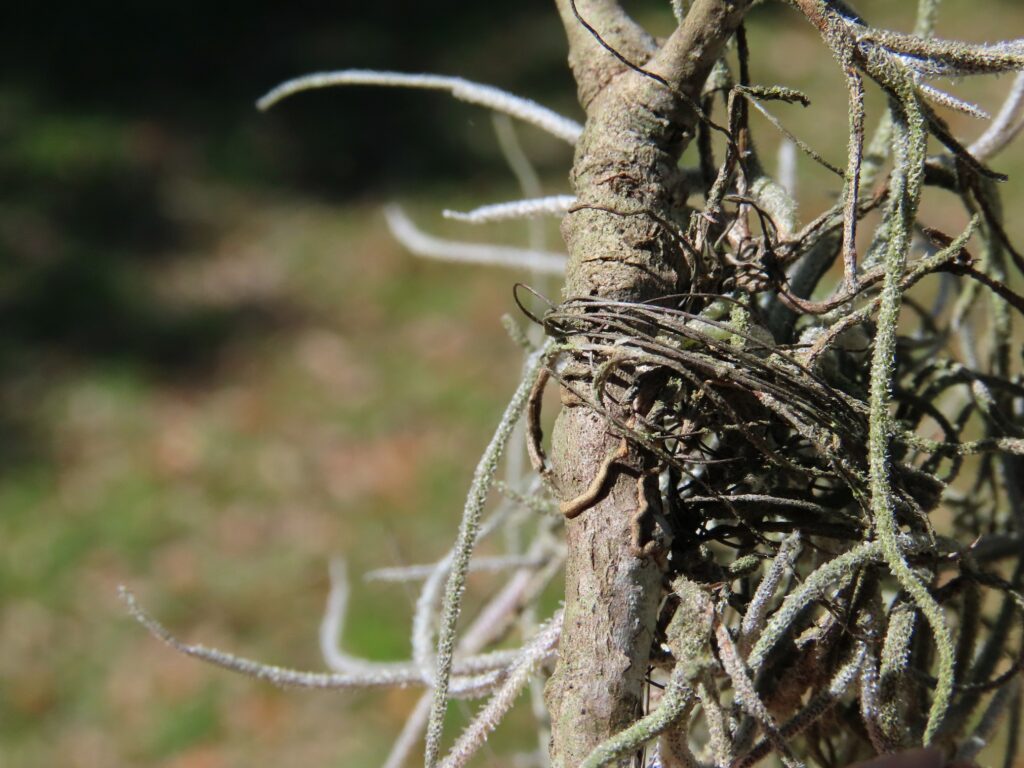
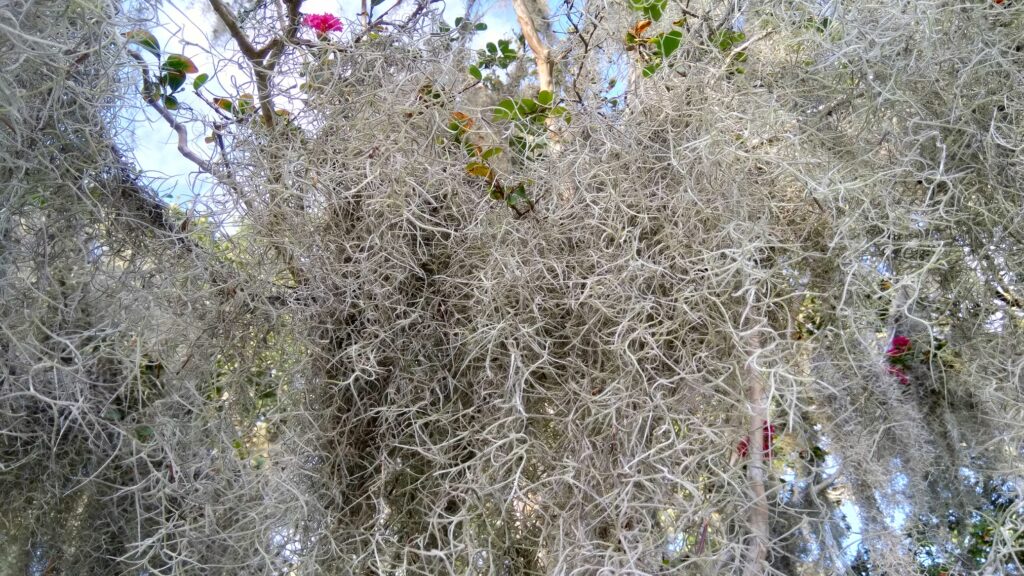
This week for Flora and Fauna Friday were learning to appreciate Spanish Moss (Tillandsia usneoides).
The sight of Live Oaks festooned in Spanish Moss, an inverted plume of smoke dipping over the bluff upon the marsh, is an iconic mark of our Edisto landscape. It’s a bewildering plant made of long, powdery-gray strings that mat and weave between each other into long beards that trail beneath the limbs of trees. It seems to appear from thin air, a gas that persists and proliferates despite any clear reason. A botanical stalactite. To many travelers, it is but a scenic addition to the coastline. Another curiosity in the holistic persona of that “Lowcountry” the locals speak of. To many of us who reside beside the sea and below the oaks it is an obnoxious weed that litters the lawn, clogs the mower, and flicks redbugs onto your wrist as you brush it aside. To me it is far more than either. It is a unique and important piece in the machine of our ecosystem. It has its place and purpose and that task is greater than what superficial character we assign it.
First let’s clear some misconceptions. Spanish Moss is neither a moss nor a parasite and it doesn’t require a host tree to grow. It’s a flowering plant and an epiphyte. More than just any old epiphyte, it’s an air plant. Spanish Moss belongs to the Bromeliads, a diverse plant family of mainly epiphytes as well as the Pineapple. Epiphytes are plants that grow on the surface of other plants without harming them. Most root into the bark of their perch and create their own blanket of soil. (Resurrection Fern is a good example of a traditional epiphyte.) Spanish Moss takes it a step further by being an air plant. Spanish Moss produces no roots other than the holdfast it uses to anchor itself to the bark of a tree. It subsists entirely off of rainwater, salt spray, windblown dust, insect excrement, and the various chemicals washed over it as rainwater trickles down the trunk of its supporting tree. As such, Spanish Moss needs no host tree if conditions are right, simply something to cling to. They will grow just fine on dead trees, eaves, and fences. Counter to common belief, they will grow on Pine Trees too. However, Pines tend to thrive in drier regions while growing taller with few limbs. Conditions Spanish Moss dislikes. As far as redbugs are concerned, those devils live near the ground in grassy areas, not in trees. So Spanish Moss undulating in the breeze is not a parasite concern.
So what good is Spanish Moss? In the past it was a favorite for stuffing furniture. The long strands were cooked to strip away the fleshy exterior and expose their dark, fibrous core. This fiber was durable and rot resistant, making a great packing material and stuffing for mattresses. But what is it good for now? Your garden and lawn of course! Spanish Moss is an air plant. That means it contains chemicals necessary for the growth of plants, and it plucked them from thin air. On top of that its flesh rapidly composts while its fiber core remains for months. It is fertilizer, compost, and mulch wrapped into one lightweight package that conveniently falls like mana from the trees! As a gardener, what’s not to love about it? This package deal of decomposition is an important part of the nutrient cycle in our maritime forests. The Spanish Moss mixes with the annual deluge of Live Oak leaves each spring to brew a rich top soil that rejuvenates thin and sandy soils, like those found on Edisto Island. If you leave it where it lay and tolerate the havoc it reeks on mower spindles, your yard will thank you. If that’s yet a bridge too far for you, do not cast it over the bluff or deposit it along the woodlot just yet. Skirt your trees, your shrubs, your vegetables, and your flowers with it and reap benefits of this curly gray gift from on high.
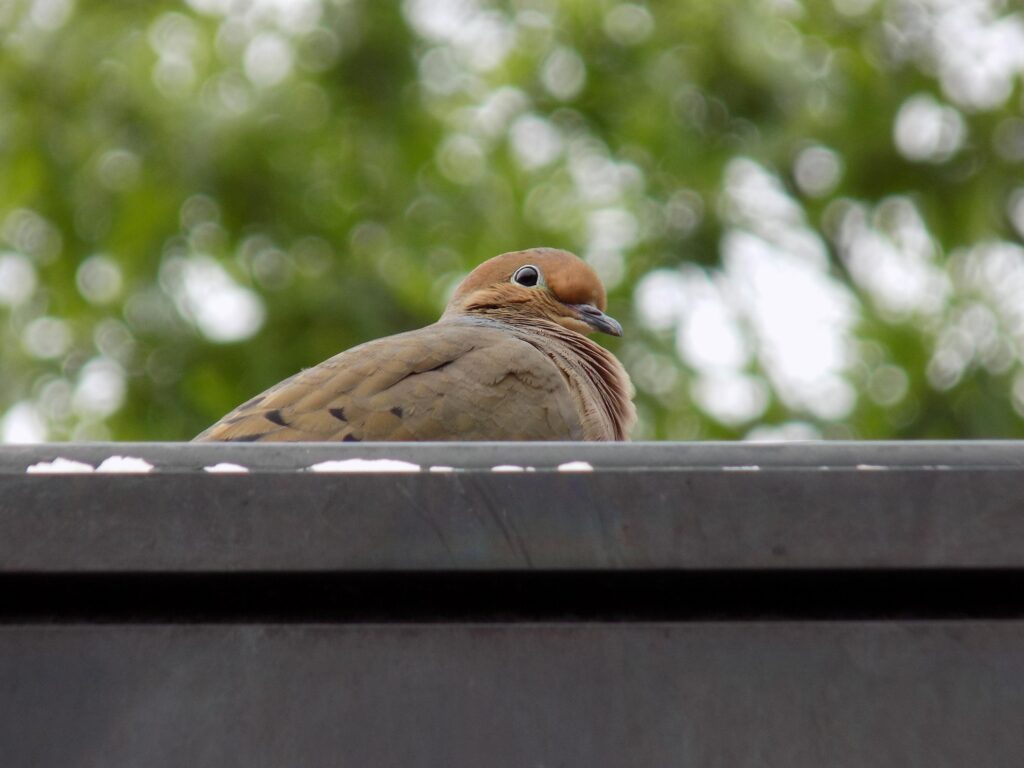

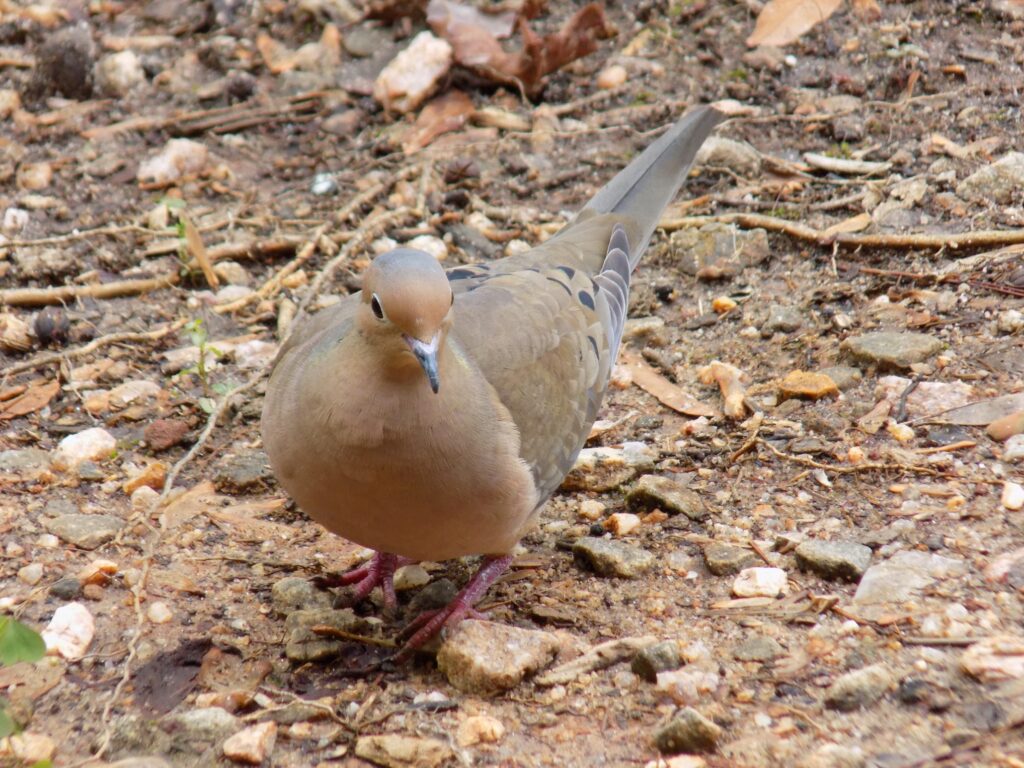
This week for Flora and Fauna Friday we’re sobered by the sound of the hollow grieving moans of the Mourning Dove (Zenaida macroura).
The Mourning Dove is a medium-sized Dove found throughout the United States. Their neck and breast are washed in rosy tones over a marble pelage and decked by wings of weathered wood with umber grains and ebony knots. They perch upright on compact coral columns, trailing their silver-trimmed and lance-headed tail. The soft lines of their rounded head encircle a beady eye of bottomless black, wearily ringed by soft swelling cyan. Darkened bags hang upon their cheeks as a blush of iridescent sunset trickles down the face. Abrupt at the front protrudes a delicate bill, down-ticked and dour. A veil of somber mourning subtly smothers the bird. An intangible aura their defeated and sorrowful song solidifies. A song of sadness, in simplest terms. As they depart, their wings whistle the echoes of a frantic sobbing that fades sharply into the empty autumn air.
Despite my anthropomorphizing to the contrary, this species is both personable and loving. Their soft, cooing song brings a tranquil nostalgia to many who hear it. Mourning Doves are undeniably stately and handsome fowl. Their large eyes and soft features produce a cherubic charm. They are a common visitor to feeders, fields, and yards where they strut in short strides to scratch and peck at scattered seeds. Doves are known to be flighty and skittish, bursting from the bare ground with explosive whistling beats. These whistles are not calls but rather the vibrating hum of their flight feathers. These reedy notes help to quickly alert other Doves of danger when one member of the flock takes flight. A trait we see in other flocking fowl, to include Mergansers and Wood Ducks. Mourning Doves mate for life. In selecting a nest the couple goes house hunting. The male leads his partner to a series of candidate sites and she chooses her favorite. (Preferably some place with granite ledges that’s in the suburbs but still close to downtown, or the crook of a tree will usually do.) Mourning Doves, along with the other Doves and Pigeons, have a unique means of feeding their young. Doves produce a substance called “pigeon-milk” from their crop, which is a pocket birds have in the esophagus for storing food. Pigeon-milk does much the same thing as regular milk but is thicker and denser with protein. Mourning Doves are one of our few species of resident game bird in SC. Although their season is sporadic, you may have enjoyed the taste of wild dove, most often baked in a bacon-wrap, on yesterday’s Thanksgiving dinner.
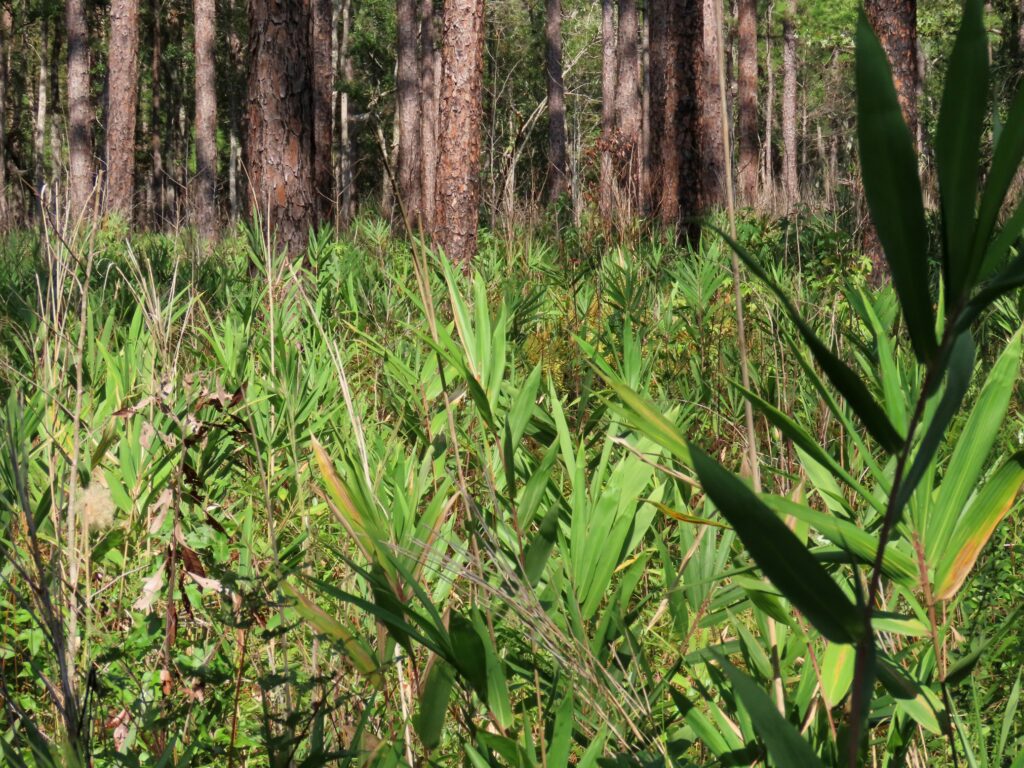

This week for Flora and Fauna Friday we have our native analogue of the iconic grass of the orient, River Cane (Arundinaria gigantea).
River Cane is a large woody grass in the Bamboo genus. It grows in dense thickets, called canebrakes. Canebrakes are found beneath the canopy of floodplain and flatwood forests or on the borders of shallow wetlands. Cane primarily spreads through its roots using underground rhizomes. It only rarely, and somewhat randomly, blooms to produce seeds. River Cane can exceed 30ft in height in extreme cases but ‘round our parts it’s usually between 5ft and 10ft. In the Lowcountry we typically see the subspecies Switch Cane (A. gigantea tecta), which is notably smaller than the Giant Cane subspecies (A. gigantea gigantea).
Like all bamboos, River Cane has a hollow cylindrical stem divided into internal chambers every 6in or so. This growth form lends the plant a rigid but flexible stem that’s very resource efficient. These stems makes the plant an incredibly versatile resource for tool making. It was used to make arrow shafts, pipes, baskets, and innumerable other contraptions by Native Americans. In modern times, I’ve used it with great success both as garden stakes and the chambers for bee motels.
River Cane is a critical plant for wildlife habitat. As previously alluded to, the hollow stems provide nesting habitat for native bees, wasps, ants, and spiders. The canebrake is a habitat used extensively for cover by rodents, frogs, and songbirds. The presence of small bite-sized critters naturally attracts their predators, which include the Canebrake Rattlesnake. A snake so named for its preference for these thickets. Cane thickets are the favored nesting and foraging habitat of the Swainson’s Warbler, Hooded Warbler, and the now extinct Bachman’s Warbler. River Cane is also the host plant for the larvae of six butterfly species, the Creole & Southern Pearly-eyes; the Yehl Skipper; and the Carolina, Reversed, & Lace-winged Roadside-Skippers.
This week for Flora and Fauna Friday everyone’s favorite, or maybe second favorite, crustacean is on the menu: Crabs. More specifically Atlantic Blue Crab (Callinectes sapidus) and Florida Stone Crab (Menippe mercenaria).
There are many species of crab found in the waters of the Lowcountry but today I’ll just be talking about the Blue Crab and the Stone Crab, the two most common eatin’-size species you’ll encounter in the creeks of Edisto Island. Both of these species are large, native, and pinchy but have very different life styles.
The Blue Crab is the staple crab of the seafood menu. They’re a large and graceful crustacean that can exceed nine inches wide from tip to tip. Their handsome shell is mottled with worn greens and browns across the back. A wash of sky blue paints the corners and peripherals of their limbs over a pearly plastron canvas. Mandarin accents their extremes on the many spines that line their limbs and carapace. A fashionable critter, no doubt. Blue Crabs are swimmers. Their streamlined profile and flattened legs let them scuttle through the water column, patrolling the creeks or bolting from danger. Blue Crabs spend their days following the tide in and out of feeder creeks in search of tasty morsels. They use their slender, pointed claws to nab fish and crustaceans, reach into the shells of snails and oysters, or hang onto carrion they discover. The Blue Crab is an economically important fishery in SC and, no matter your technique for catching them, crabbing is a ubiquitous Lowcountry pastime.
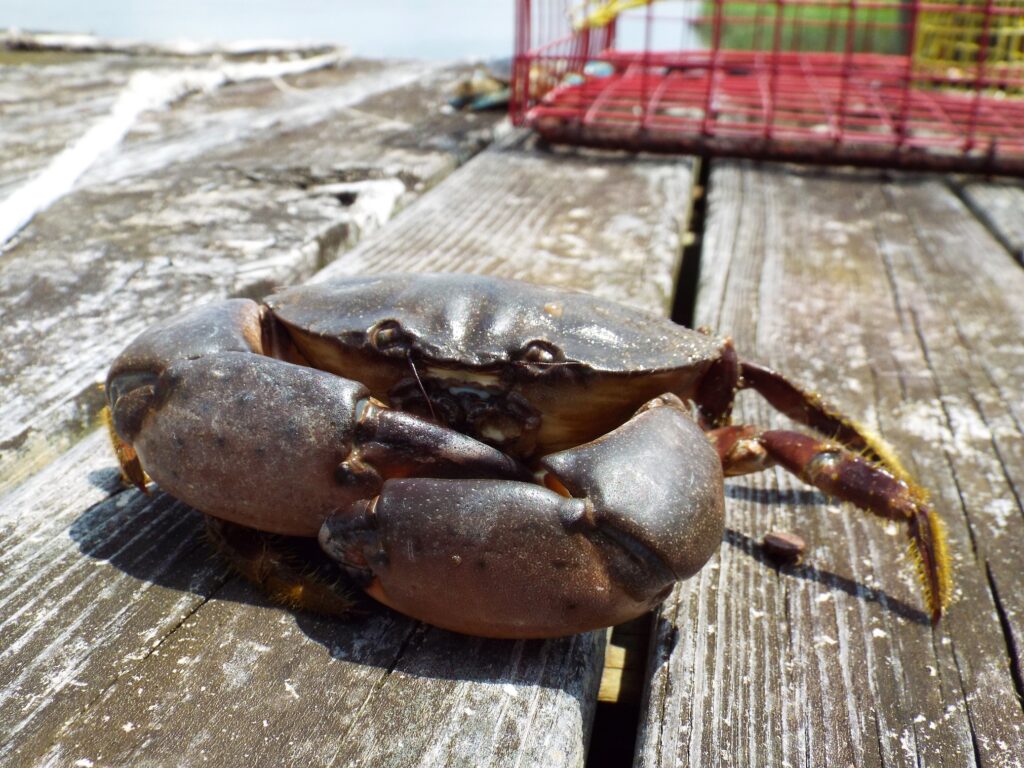
The Stone Crab is a substantial, barrel-chested crustacean that reaches six inches in width. They’re a mix of pluffmud-gray and burgundy across their armored body with thin, pointed legs and two intimidating pincers. They bide their lives in the tidal creeks hanging around oyster reefs and dock structures. Nearby they build the burrows they retreat to between tides. Upon the reefs they feed on Oysters, Mussels, small crustaceans, and any dead things they chance to encounter. Unlike Blue Crabs, they cannot swim and thus cannot move freely with the tides or escape predators. Instead, they rely on their pointy feet to anchor themselves to the oysters while their heavily armored shell thwarts nibbling. Their big meaty claws pinch the snot out of any fish or finger that gets too close. Speaking of big meaty claws, Stone Crabs have asymmetrical claws, one crusher claw and one pincer claw. These claws serve different purposes during feeding. One is shaped to break shell and bone. The other more slim, to pick at the softer bits. Still on about them claws, it is legal to harvest Stone Crab claws with a saltwater fishing license in SC but only one claw of legal size may be taken per crab.
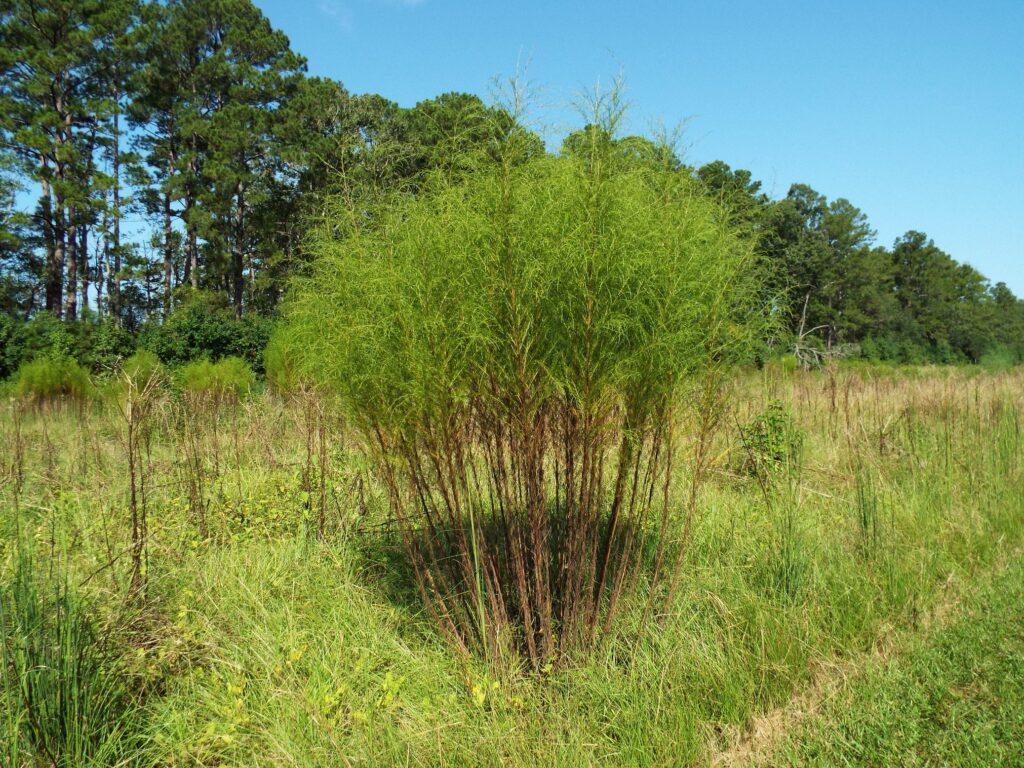

This week for Flora and Fauna Friday we have a common fragrant weed of roadsides and fallow fields, Dogfennel (Eupatorium capillifolium).
Despite what you may have been led to believe, Dogfennel is neither a dog nor a fennel. It’s actually a perennial member of the Aster family, Asteraceae, and a member of the Boneset genus. However, unlike other Bonesets, Dogfennel produces neither pollen nor nectar for our pollinating insects. It is entirely wind pollinated. Its seeds are also wind dispersed and fly their way to fields, gardens, and bare earth across the South. Its vigorous growth lets it establish quickly and soon grows taller than a man. Its stem is stiff and woody beneath a sheen of translucent fuzz and feathery emerald-green foliage. In mid-fall Dogfennel blooms with a spray of minute gray-white flowers. The cycle repeats.
On an aside, despite what is commonly told the essential oils found in Dogfennel do not repel mosquitoes. However, these same oils lend the plant its flagrantly fragrant scent and make the leaves unappetizing to herbivores. Also it’s mildly poisonous. So nothing eats it. I’ll be frank, Dogfennel is a certainly weed if ever there was one. It has little merit in most ecosystems but it’s not without some benefit. Old Dogfennel stems provide habitat for cavity nesting bees and other such insects. However, its most important role is that of soil stabilization and ecosystem pioneering. Dogfennel is very adept at spreading to and establishing in new habitat. If there’s bare ground out there, you can be sure Dogfennel will find it. Once established, it quickly grows a deep taproot. This helps protect soil from erosion and facilitates other plants to establish. This also creates some cover and perches for wildlife to use in what would otherwise be a barren environment. Over time dogfennel will get crowded out by grasses and trees. And so, this plant begins anew some miles and a generation away where the clay lays bare.
This week for Flora and Fauna Friday it’s a group of insect entangling arachnids, the Orbweavers of family Araneidae.
The Orbweavers are a diverse group of pendulous predators common throughout the woods of Edisto. They can be found pretty much anywhere there’s something to stick their webs too and something to eat. These spiders quite literally come in all shapes, sizes, and colors to suit the various micro-habitats they prefer. However, all our common Orbweavers are similar in that they build a vertical web between openings in vegetation to trap flying insects. This web is covered in a sticky glue that adheres to anything that touches it. The spider then attacks the trapped insect, injecting it with venom, before wrapping it up in a silken coffin for later snacking. Females are an order of magnitude larger than males and typically colorful and complex in their abdominal shape. Today I’ll be highlighting four of the more common and recognizable species of the approximately thirty Orbweavers that can be found on our Island. Our stars today are the Spinybacked Orbweaver (Gasteracantha cancriformis), Black-and-Yellow Argiope (Argiope aurantia), Golden Silk Orbweaver (Trichonephila clavipes), and Giant Lichen Orbweaver (Araneus bicentenarius).
The Spinybacked Orbweaver is the most easily recognized of this already recognizable bunch. It’s a small Orbweaver that’s wider than it is long. Females are totally black underneath with a white mantle ringed in deep-red spines. They build oversized webs for their size and will flag their anchor threads with tufts of silk to help birds avoid the webbing. This saves our little spider from having to build a new web every time a cardinal careens through it.
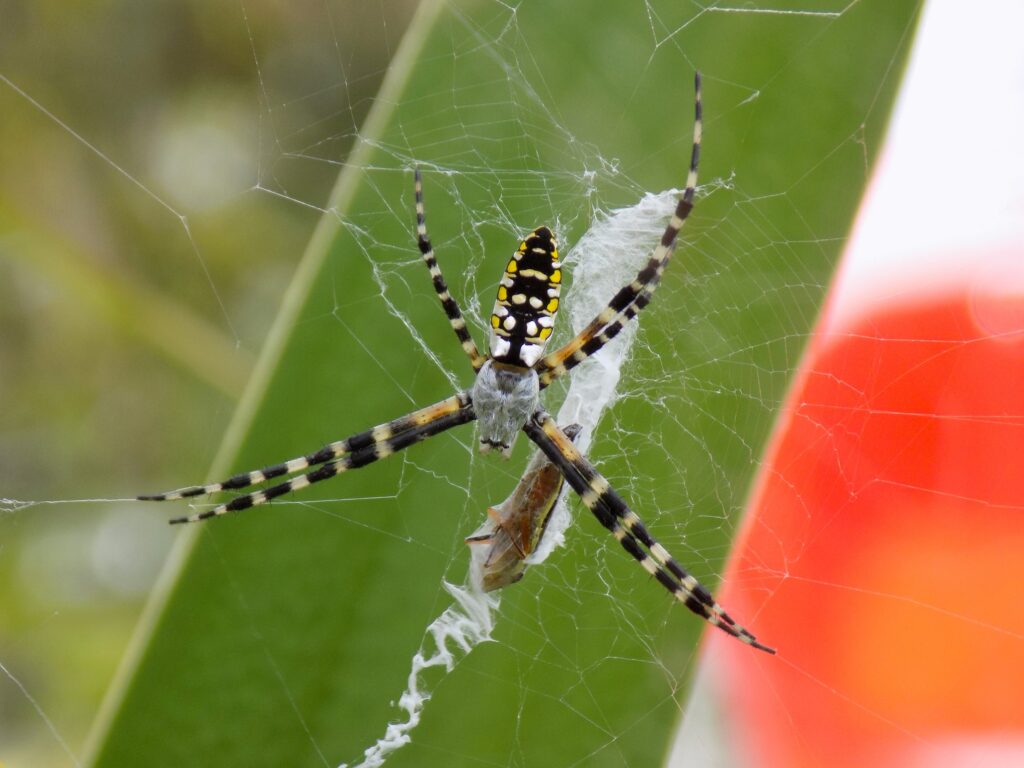
The Black-and-Yellow Argiope is an Orbweaver commonly found in residential areas. Females have a large oval abdomen with a broken yellow border of bands on a black background, a silvery-gray thorax, and long two-tone legs. They prefer meadows, freshwater wetlands, gardens, and other densely vegetated habitats. They build webs lower to the ground than other large Orbweavers, often garnished with a vertical zig-zagging zipper of white silk down the center.
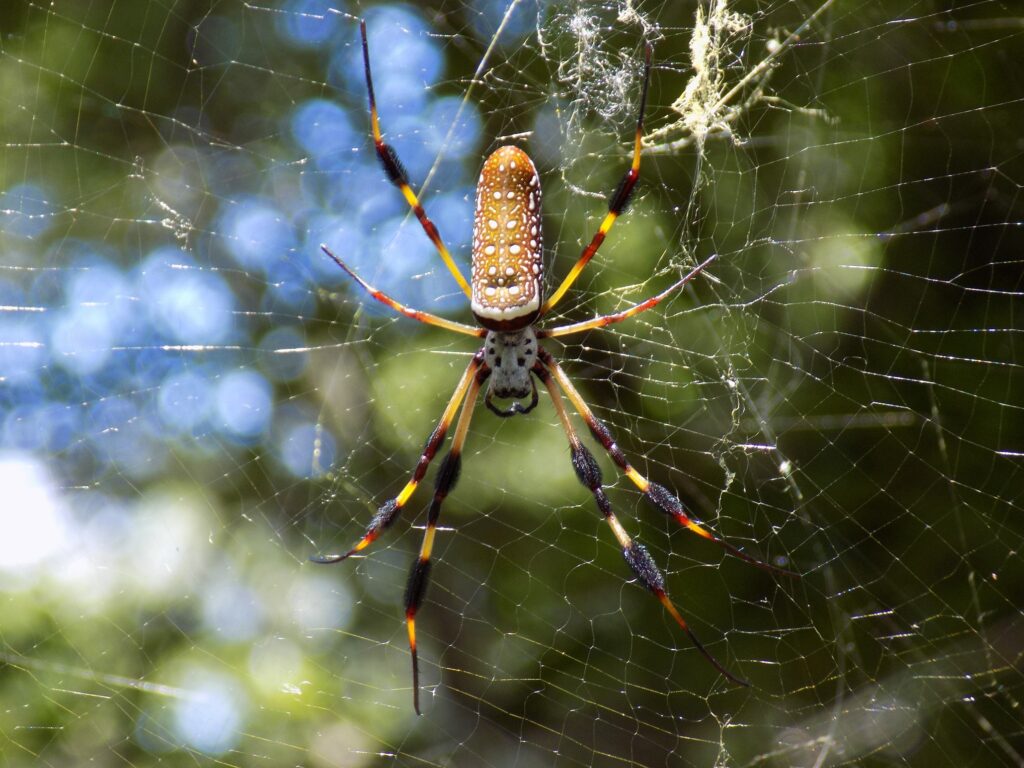
The Golden Silk Orbweaver (AKA Banana Spider) is the most common Orbweaver you’ll encounter in our forests. (Usually with your face.) Females are large and lanky with an aluminum-gray thorax, speckled orange abdomen, and long yellow legs with fluffy black legwarmers above the joints. They build massive webs that are often three-dimensional and disorganized. Unlike other orbweavers, they don’t rebuild their nest but instead just keep adding thread after each instance of damage. Their webs may be high in the trees or right at eye level. Their dragline silk is noteworthy for being a reflective gold color and unbelievably strong.
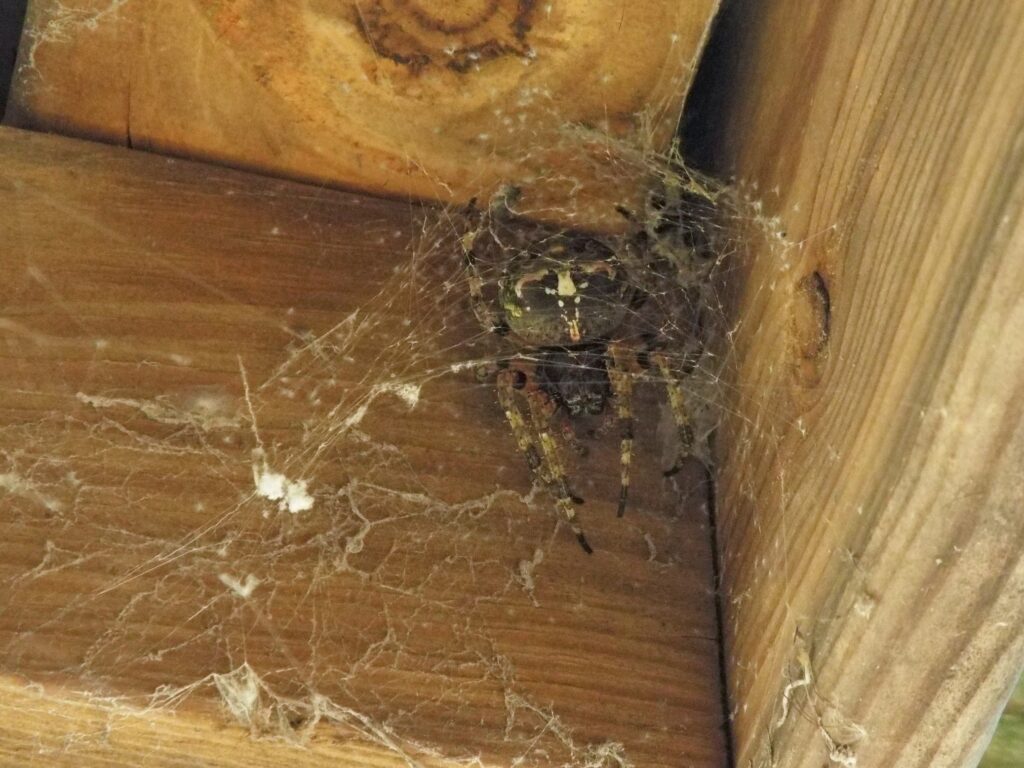
The Giant Lichen Orbweaver is one of the heftiest spiders you’ll encounter on Edisto. A female’s abdomen is roughly the size of a ping-pong ball and about the same shape. Unlike the others, she has a highly camouflaged coloration with a wash of soft green and spots of white over a background of browns. She builds her web from the low branches of a tree to the ground beneath. Then she tucks herself into a cozy corner between the leaves and mosses to wait for some unlucky soul to fall into her trap. Giant Lichen Orbweaver are even known to eat small vertebrates, most commonly Anoles.
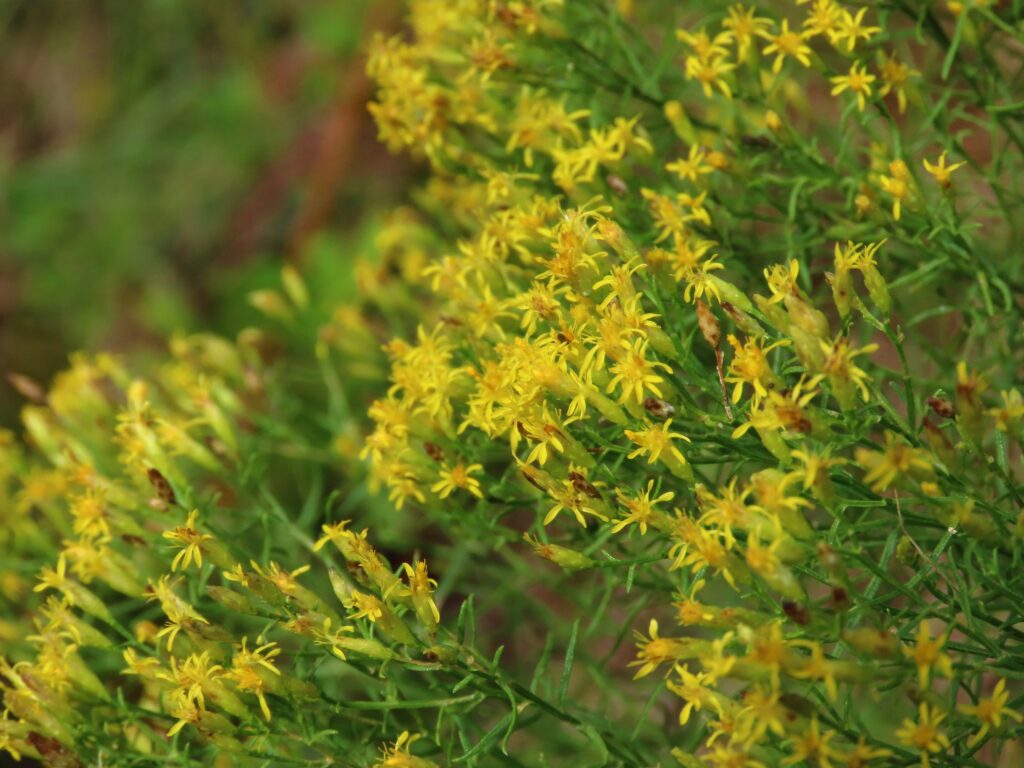

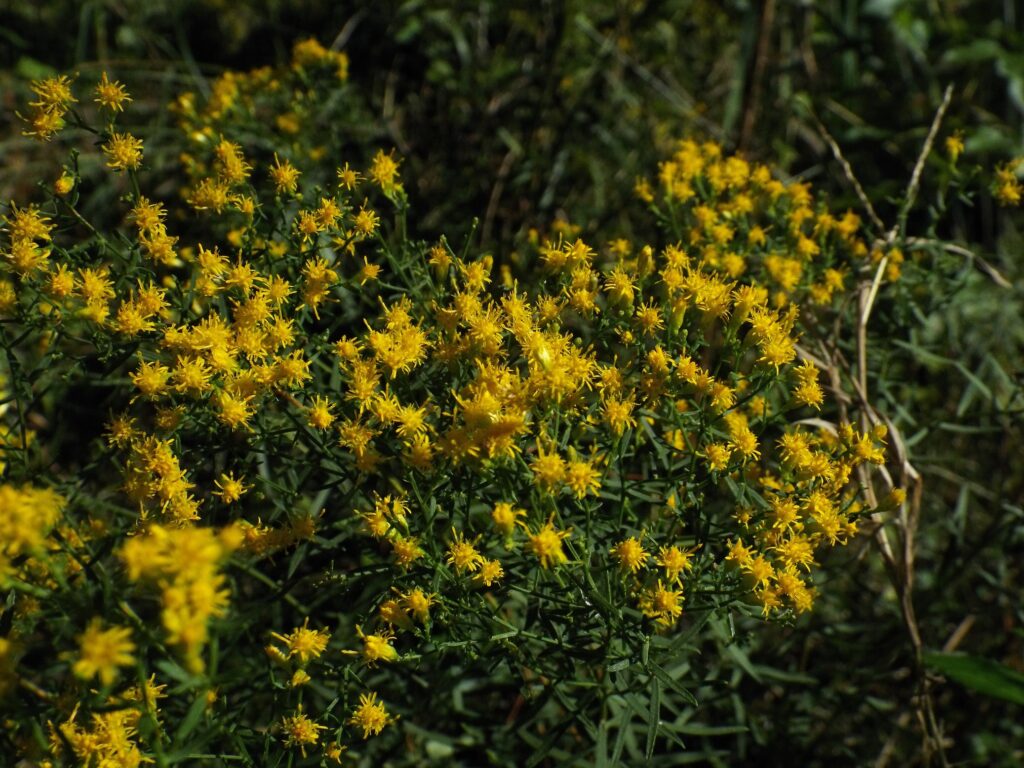
This week for Flora and Fauna Friday it’s a stringy coastal wildflower of the yellow variety known as Slender Goldentop (Euthamia caroliniana).
Slender Goldentop is a perennial wildflower common throughout the maritime forests of Edisto Island. Its shaggy cone of wiry leaves on narrow stems reach the hip. Above the Fimbry and below the Switchgrass through the fringes of the marsh. An appearance not misplaced in the coarse and gnarled flora of the saline floodplain. There it grows quiet and hidden through the warmest parts of the year. Flowers emerge amidst autumn across the plateau of the plant. Small, unkempt, and golden in frothing plumes above the escarpments of the marsh. The plants are common inland as well but never so regular as they are here.
The plant is a reliable source of nectar but often over-shadowed by more productive late-season wildflowers. Many pollinators seek their meals at its neighbors but entertain on its spray of flowers when those others wither away. Slender Goldentop is close kin to Goldenrods, which from its appearance you would predict. Goldentops have a bushier, compacted growth-form than Goldenrods. A trait which makes them easy to pick apart despite the same deep-yellow flares of flowers flown by both.




This week for Flora and Fauna Friday we have the chicken’s bane, the Yellow Rat Snake (Pantherophis alleghaniensis).
The Eastern Rat Snake is one of the most common snakes you’ll encounter in the State. Here on the coast, we have the Yellow morph; the upstate has the Black morph. The Yellow Rat Snake is a large snake often reaching or exceeding five feet in length. Adults are greenish-yellow with four black stripes down the length of their back. Juveniles are gray and blotched with brown. When a Rat Snake detects danger at a distance, it will usually freeze and kink its body like a crinkle-cut French fry, to break up its outline and impersonate a stick. When danger gets too close for comfort they will flee underneath brush if possible or, more often than not, assume a strike position. Here they do their darndest to intimidate, vibrating the tip of their tail in leaf litter to mimic a Rattlesnake and striking at anything that gets in range. Their goal is to bluff and not to outright bite but, despite being a non-venomous constrictor, they will not hesitate to bite the snot out of anyone that accosts them.
Rat Snakes are masters in the art of climbing. They can scale shrubberies, brick walls, and tree bark with ease. They’ll even scale a one-inch pole like it’s nothing. Rat Snakes use this scaly scaling to find their preferred food, bird nests. Rat Snakes love eggs and swallowing them whole. They’re a major predator of our large cavity nesting birds, like Wood Ducks and woodpeckers. They’ll also eat anything else they encounter in a tree cavity including baby birds, adult birds, squirrels, tree frogs, and lizards. Once they get into a nest, they’re almost impossible to remove against their will. However, birds don’t nest year-round. So the bulk of their diet is mice and rats. Rat Snakes are also called Chicken Snakes. This comes from their regular habit of squeezing into coops, sucking eggs, sending the chickens into a tizzy, and waking up the farmer at an ungodly hour. They’re also a hazard to Bluebird boxes and Martin houses around people’s homes. They easily defeating most defenses and drive away nesting birds.


This week for Flora and Fauna Friday we have an easily over-looked wildflower, Wooly Elephant’s-Foot (Elephantopus tomentosus). We have four species of Elephant’s-Foot on Edisto but all are so similar in appearance that it’s easiest if I just speak about our most common species.
Wooly Elephant’s-Foot is a low growing perennial that loves well drained soils and heavy shade. You’ll most often find it growing on wooded ridges and along roads or trails under a canopy of hardwoods. It does best in barren or thinly vegetated areas where there are frequent patches of bare soil. Its large, tear-drop leaves drape the surface of the soil to form a basal rosette the size of a dinner plate. Each leaf is about eight inches long and covered in a layer of fuzz. In ideal conditions, the species can be quite prolific and blankets the ground in an evergreen quilt. The species will also make its home in shady lawns between the stems of St. Augustine Grass.
In late summer thru to fall Wooly Elephant’s-Foot blooms, extending a thin, forked stem one to two feet above the ground. Each tine is capped by a cluster of flowers. The flowers of all species are typically pink or magenta but some are pure white. Each flower has five petals that are skewed to one side, giving the impression of an open hand. Each flower is either discrete from one another or in clusters of up to four. These flowers are adored by pollinators from all walks of life. The unique combination of features from this flowering plant come together to make its nectar accessible to both the smallest of flies and the largest of butterflies. Stiff stems and broad clusters allow Giant Swallowtails and Southern Plains Bumble Bees to perch whilst they frantically gulp down nectar. All the while their short flowers with a broad mouth offer quiet dining to even the smallest of Hoverflies and Flower Beetles. It’s rare for one nectar plant to be so universally agreeable. Most plants specialize in some aspect for a particular group of insects but Elephant’s-Foot is hospitable to all six-legged critters.